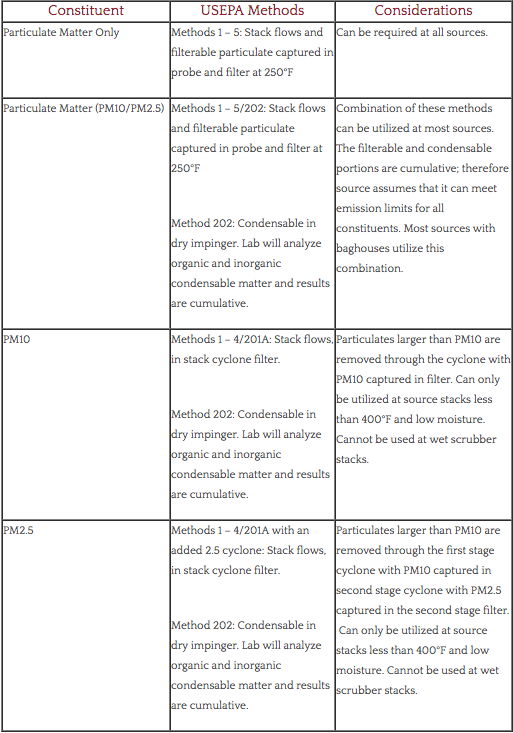Since air emission standards were first established in 1971, periodic review of the standards has resulted in the standards being regularly revised. With respect to particulate matter regulations, the United States Environmental Protection Agency (USEPA) has focused on adding standards of ever increasingly fine particulate matter to the National Ambient Air Quality Standards (NAAQS).
The first change occurred in 1987 when particulate deemed to be inhalable was regulated as Particulate Matter with an aerodynamic diameter less than 10 microns (PM10). Driven by concerns of a link between serious health problems, particularly heart and lung disease, and ambient exposure to fine particles, the USEPA chose to add a standard for Particulate Matter with an aerodynamic diameter of 2.5 microns or less (PM2.5) in 1997. Additional modifications to these standards occurred in 2006, as the daily PM2.5 limit was more stringent. Because an ambient PM2.5 standard exists, the USEPA directed the states to establish emission limits for PM2.5 after January 1, 2011. Accordingly, the Indiana Department of Environmental Management (IDEM) and other state regulatory authorities have begun to include PM2.5 limits in air permits.
The USEPA developed methodologies to determine compliance with emission limits. Stack testing methodologies to determine particulate concentrations separate filterable from condensable particulates. Filterable particulates are emitted to a stack in a solid or liquid form and are captured on a filter in the stack test train. Filterable particulates are generally larger than 2.5 microns. Conversely, condensable particulates are emitted to a stack in vapor form, but condense upon cooling and dilution in the ambient air to form a solid or liquid particulate immediately after discharge from a stack. Condensable particulates are generally smaller than 2.5 microns. Further, condensable particulates may react with airstream components as they condense.
If stack temperatures are less than 85 degrees Fahrenheit, it can be assumed that all particulate are filterable and USEPA Method 5 can be used to complete any required particulate sampling. This method, which typically employs a probe and a filter heated to 250 degrees Fahrenheit, should be run at temperatures less than 85 degrees Fahrenheit in order to “catch” all particulate matter, including condensables. However, should stack gas temperatures exceed 85 degrees Fahrenheit, condensable particulates are required to be collected according to USEPA Method 202 in conjunction with filterable particulate method to determine the total particulate concentration. The most common industrial sources which require sample collection of condensable particulate are combustion sources, such as boilers, turbines, incinerators, furnaces (such as melt) and process heaters.
Since the promulgation of USEPA Method 202 in 1991, evaluation of the data generated by the method resulted in the conclusion that the method resulted in a positive bias and a lack of the requisite reproducibility. The primary source of the bias was determined to be sulfur dioxide, which would be collected in the sampling train impinger water. There it reacts with the water and forms sulfate, which is detectable as PM2.5. EPA evaluated many concepts to improve the method, involving both state regulators and stakeholders in the regulated community in the evaluation process. The EPA promulgated the revised method in December 2010, with two primary modifications. First, the sampling train is required to be purged for one hour after sampling to remove and dissolved sulfur dioxide. Second, the impingers used in the sampling train are to be dry, rather than the previous water-filled impinger method. Using the dry impingers is intended to eliminate any sulfate artifacts.
The following methodologies and descriptions will provide the source guidance on how best to acquire the information that the regulatory agency or source engineering requires:

The USEPA’s intention in the implementation of this rule is to employ a method that more accurately determines the presence of condensable particulate matter. While the USEPA has indicated that generally the old method resulted in a positive bias, it is wise not to assume that this will be the case in each individual situation. The Air Analysis Division of Wilcox Environmental Engineering has performed a series of PM2.5/202 tests on baghouses at some industrial sources and surprisingly found condensable results to be higher than in years past. However, the results of these tests cannot be effectively compared, because the old Method 202 was not run in conjunction with the new Method 202. Because of the method change and the uncertainties of the results, it is recommended that an engineering study be conducted prior to a compliance test.
